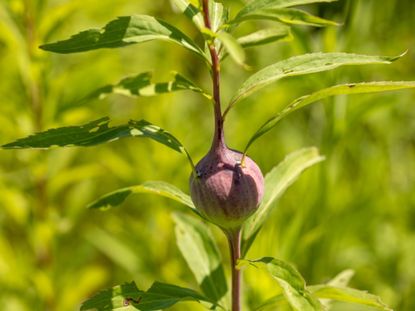Goldenrod Gall Fly Causing Lumps On Plant Stems


Goldenrod is a common wildflower of eastern and central North America that is host to the goldenrod gall fly larvae (Eurosta solidaginis). The larvae themselves aren’t seen, but instead secrete themselves within a goldenrod gall inside of which they eat and grow well away from predators. The goldenrod gall fly life cycle in its entirety is fascinating. Keep reading to learn about this intriguing fly.
About Goldenrod Wildflowers
Goldenrod, a member of the Asteraceae or aster family, is a weedy, perennial herb. With over 150 species, this wildflower can be found in prairies, fields, roadsides and disturbed land areas. Along with this often invasive weed, comes the swollen ball-shaped galls formed by the goldenrod gall fly.
Not every variety of goldenrod is suitable for egg laying to the female goldenrod gall fly. Her preference is for Canada goldenrod, late goldenrod, or giant goldenrod, and her fastidiousness extends towards “tasting” each plant with the chemical sensors on her feet and antennae until she finds just the right plant on which to lay her eggs.
Life Cycle of the Goldenrod Gall Fly
The entire life cycle of the gall fly revolves around the goldenrod plant. In the spring, males perch atop the goldenrod, dancing and flicking their wings to attract a mate. Once a female picks a male, they mate.
The female then deposits the fertilized eggs into the terminal bud of the goldenrod plant of her choice. Females can lay many hundreds of eggs, but each stem ends up with only one gall. The eggs hatch after several days as tiny, white to cream colored larvae which immediately begin to feed inside the stem.
A chemical in the larval fly’s saliva causes the plant to grow abnormally, increasing cell production and forming a gall that appears about three weeks after eggs are laid.
Goldenrod Gall
At first, the gall is the same green color of the goldenrod’s stem. After some time however, the gall grows to about the size of a golf ball accompanied by a red or purple hue. Inside the gall, the tissue is hard with a consistency of damp wood.
Gardening tips, videos, info and more delivered right to your inbox!
Sign up for the Gardening Know How newsletter today and receive a free download of our most popular eBook "How to Grow Delicious Tomatoes."
The leaves abutting the gall wither and brown, but otherwise the gall doesn’t seem to have a detrimental effect on the plant, which still blooms.
The larvae feed the entire summer, molting twice. In preparation for emergence in the spring, the larva chew a tunnel to the gall’s surface. The mature larvae overwinters inside the gall and then when spring temps warm emerge using the previously prepared escape route.
Additional Goldenrod Gall Info
Even though the fly larvae have protection inside the galls, they are not immune from predation. Two types of wasps use the larvae parasitically to grow their young, and some birds like the downy woodpecker and the black-capped chickadee are predators of the larvae. Also in some areas, fishermen harvest the galls and use the larvae as bait.
The parasitic wasps exploit smaller galls while the larger birds prefer larger galls. Therefore it is easy to see which predator is most abundant due to the size of galls in an area.
Goldenrod gall flies are not the only species that creates galls on goldenrod. Gnormimoschema gallesolidaginis is a moth that causes concise oval galls in stems, and Rhopalomya solidaginis, the goldenrod bunch gall midge causes a puckered, rosette cluster of leaves to form in the terminal bud on Canada goldenrod.

Amy Grant has been gardening for 30 years and writing for 15. A professional chef and caterer, Amy's area of expertise is culinary gardening.
-
 Cheap Fence Ideas For A Pretty And Private Yard
Cheap Fence Ideas For A Pretty And Private YardYou don’t need to spend a fortune to box in your garden. Take these cheap fencing ideas for your garden and budget and run with them.
By Mary Ellen Ellis
-
 How To Attract Cardinals – Get Beautiful Songbirds Flocking To Your Yard
How To Attract Cardinals – Get Beautiful Songbirds Flocking To Your YardThe northern cardinal is a national treasure and a delight to spot in the garden, nesting in shrubbery and flitting between feeders. Discover how to attract this beloved songbird by providing the right food, shelter, and water.
By Melanie Griffiths